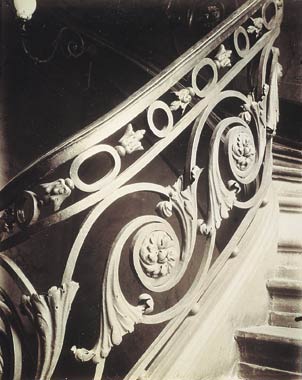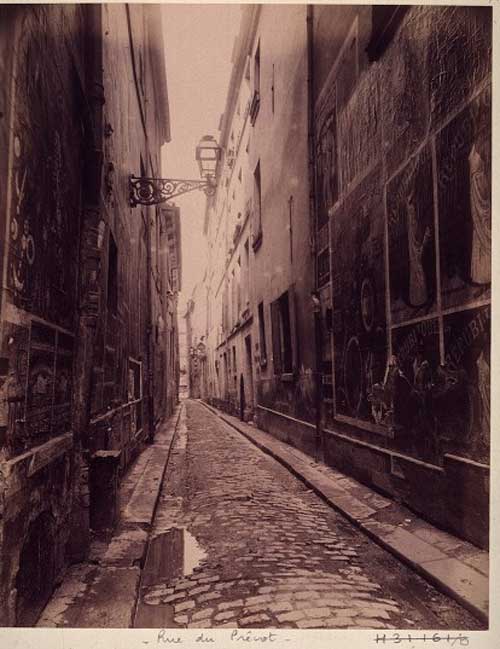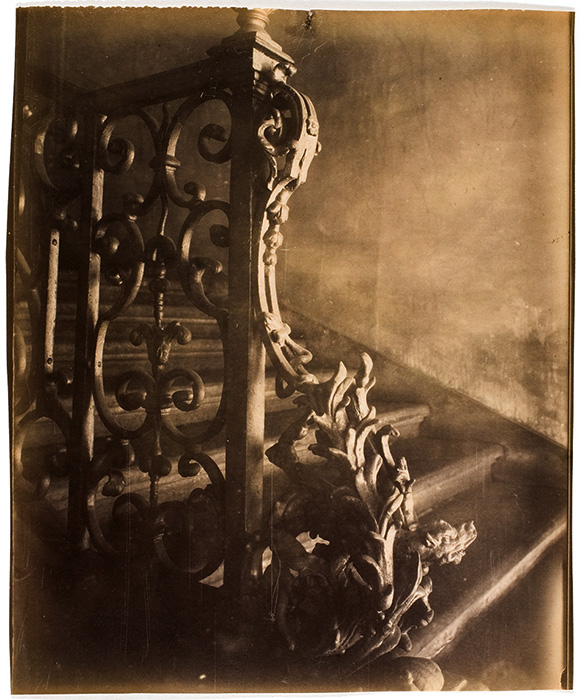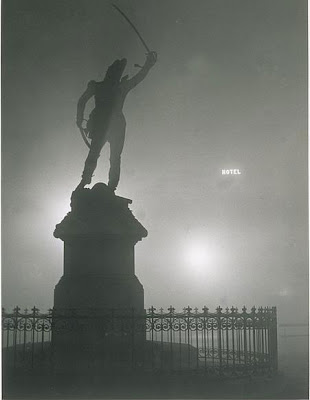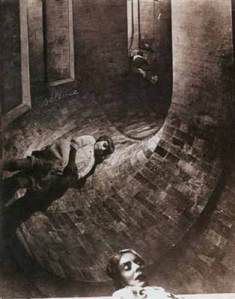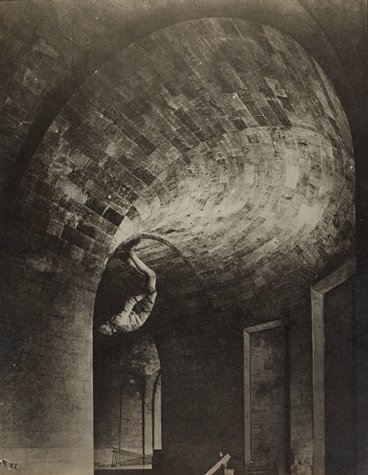Cinema 1: L’Image-Mouvement (Movement-Image)
p169:
« espaces deconnectés ou vidés »
« situation de l’après-guerre avec ses villes démolies ou en reconstruction, ses terrains vagues, ses bidonvilles »
« crise de l’image-action: les personnages se trouvaient de moins en moins dans des situations sensori-motrices « motivantes », mais plutôt dans un état de promenade, de balade ou d’errance qui définissait des situations optiques et sonores pures. L’image-action tendait alors à éclater, tandis que les lieux déterminés s’estompaient, laissant monter des espaces quelconques où se développaient les affects modernes de peur, de détachement, mais aussi de fraîcheur, de vitesse extrême et d’attente interminable. »
p170:
« L’école allemande de la peur, notamment avec Fassbinder et Daniel Schmid, élaborait ses extérieurs comme des villes-déserts, ses intérieurs dédoublés dans des miroirs, avec un minimum de repères et une multiplication de points de vue sans raccord. »
p280:
« Ce qui a remplacé l’action ou la situation sensori-motrice, c’est la promenade, la balade et l’aller-retour continuel. La balade avait trouvé en Amérique les conditions formelles et matérielles d’un renouvellement. Elle se fait par nécessité, intérieure ou extérieure, par besoin de fuite. Mais maintenant elle perd l’aspect initiatique qu’elle avait encore dans le voyage allemand (encore dans les films de Wenders), et qu’elle conservait malgré tout dans le voyage beat (« Easy Rider » […]). elle est devenue balade urbaine, et s’est détachée de la structure active et affective qui la soutenait, la dirigeait, lui donnait des directions même vagues. […] C’est en effet le plus clair de la balade moderne, elle se fait dans un espace quelconque, gare de triage, entrepôt désaffecté, tissu dédifférencié de la ville, par opposition à l’action qui se déroulait le plus souvent dans les espaces-temps qualifiés de l’ancien réalisme. »
p281:
« la réalité dispersive et lacunaire, le fourmillement de personnages à interférence faible, leur capacité de devenir principaux et de redevenir secondaires, les évènements qui se posent sur les personnages et qui n’appartiennent pas à ceux qui les subissent ou les provoquent. »
« Ce sont ces images flottantes,ces clichés anonymes, qui circulent dans le monde extérieur, mais aussi qui pénètrent chacun et constituent son monde intérieur, si bien que chacun ne possède en soi que des clichés psychiques par lesquels il pense et il sent, se pense et se sent, étant lui-même un cliché parmi les autres dans le monde qui l’entoure. Clichés physiques, optiques et sonores, et clichés psychiques se nourissent mutuellement. Pour que les gens se supportent, eux-mêmes et le monde, il faut que la misère ait gagné l’intérieur des consciences, et que le dedans soit comme le dehors. »
p282:
« L’idée d’une seule et même misère, intérieure et extérieure, dans le monde et dans la conscience, c’était déjà l’idée du romantisme anglais sous sa forme la plus noire, notamment chez Blake ou Coleridge: les gens n’accepteraient pas l’intolérable si les mêmes « raisons » qui le leur imposaient du dehors ne s’insinuaient en eux pour les faire adhérer du dedans. »
p286:
« Dans la ville en démolition ou en reconstruction, le néo-réalisme fait proliférer les espaces quelconques, cancer urbain, tissu indidéfférencié, terrains vagues, qui s’opposent aux espaces déterminés de l’ancien réalisme. Et ce qui monte à l’horizon, ce qui se profile dans ce monde, ce qui va s’imposer dans un troisième moment, ce n’est même pas la réalité crue, mais sa doublure, le règne des clichés, tant à l’intérieur qu’à l’extérieur, dans la tête et le cœur des gens autant que dans l’espace tout entier. »
Cinéma 2: L’Image-Temps (Time-Image)
p15:
« Quant à la distinction du subjectif et de l’objectif, elle tend aussi à perdre de son importance, à mesure que la situation optique ou la description visuelle remplacent l’action motrice. On tombe en effet dans un principe d’indéterminabilité, d’indiscernabilité: on ne sait plus ce qui est imaginaire ou réel, physique ou mental dans la situation, non pas qu’on les confonde, mais parce qu’on n’a pas à le savoir et qu’il n’y a même plus lieu de le demander. C’est comme si le réel et l’imaginaire couraient l’un derrière l’autre, se réfléchissaient l’un dans l’autre autour d’un point d’indiscernabilité. »
« une description réaliste traditionnelle: c’est celle qui suppose l’indépendance de son objet, et pose donc une discernabilité du réel et de l’imaginaire (on peut les confondre, ils n’en restent pas moins distincts en droit). Tout autre est la description néo-réaliste du nouveau roman: comme elle remplace son propre objet, pour une part elle en gomme ou en détruit la réalité qui passe dans l’imaginaire, mais d’autre part elle en fait surgir toute la réalité que l’imaginaire ou le mental créent par la parole et la vision. L’imaginaire et le réel deviennent indiscernables. »
p16:
« Chez Fellini déjà, telle ou telle image est évidemment subjective, mentale, souvenir ou fantasme, mais elle ne s’organise pas en spectacle sans devenir objective, sans passer dans les coulisses, dans « la réalité du spectacle, de ceux qui le font, qui en vivent, qui s’y prennent »: le monde mental d’un personnage se peuple si bien d’autres personnages proliférant qu’il devient inter-mental, et aboutit par aplatissement des perspectives « à une vision neutre, impersonelle (…), notre monde à tous. » »
« Le regard imaginaire fait du réel quelque chose d’imaginaire, en même temps qu’il devient réel à son tour et nous redonne de la réalité. »
« les situations optiques et sonores pures peuvent avoir deux pôles, objectif et subjectif, réel et imaginaire, physique et mental. Mais elles donnent lieu à des opsignes et sonsignes, qui ne cessent de faire communiquer les pôles, et qui, dans un sens ou dans l’autre, assurent les passages et les conversions, tendant vers un point d’indiscernabilité (et non pas de confusion).
P35: conscience-camera
« elle [la caméra] subordonne la description d’un espace à des fonctions de la pensée. Ce n’est plus la simple distinction du subjectif et de l’objectif, du réel et de l’imaginaire, c’est au contraire leur indiscernabilité qui va doter la caméra d’un riche ensemble de fonctions, et entraîner une nouvelle conception du cadre et des recadrages. S’accomplira le pressentiment d’Hitchcock: une conscience-caméra qui ne se définirait plus par les mouvements qu’elle est capable de suivre ou d’accomplir, mais par les relations mentales dans lesquelles elle est capable d’entrer; Et elle devient questionnante, répondante, objectante, provocante, théorématisante, hypothétisante, expérimentante. »
p58: « le cinéma dit moderne »
« Des personnages, pris dans des situations optiques et sonores pures, se trouvent condamnés à l’errance ou à la balade. Ce sont de purs voyants, qui n’existent plus que dans l’intervalle de mouvement, et n’ont même pas la consolation du sublime, qui leur ferait rejoindre la matière ou conquérir l’esprit. Ils sont plutôt livrés à quelque chose d’intolérable, qui est leur quotidienneté même. »
« Les images-rêve à leur tour semblent bien avoir deux pôles, qu’on peut distinguer d’après leur production technique. L’un procède par des moyens riches et surchargés, fondus, surimpressions, décadrages, mouvements complexes d’appareil, effets spéciaux, manipulations de laboratoire, allant jusqu’à l’abstrait, tendant à l’abstraction. L’autre au contraire est très sobre, opérant par franches coupures ou montage-cut, procédant seulement à un perpétuel décrochage qui « fait » rêve, mais entre objets demeurant concrets. La technique de l’image renvoie toujours à une métaphysique de l’imagination: c’est comme deux manières de concevoir le passage d’une image à l’autre. A cet égard, les états oniriques sont par rapport au réel un peu comme les états « anormaux » d’une langue par rapport à la langue courante: tantôt surcharge, complexification, sursaturation, tantôt au contraire élimination, ellipse, rupture, coupure, décrochage. »
p94: Image-cristal
« L’image-cristal, ou la description cristalline, a bien deux faces qui ne se confondent pas. C’est que la confusion du réel et de l’imaginaire est une simple erreur de fait, et n’affecte pas leur discernabilité: la confusion se fait seulement « dans la tête » de quelqu’un. Tandis que l’indiscernabilité constitueune illusion objective; elle ne supprime pas la distinction des deux faces, mais la rend inassignable, chaque face prenant le rôle de l’autre dans une relation qu’il faut qualifier de présupposition réciproque, ou de réversibilité. […] L’indiscernabilité du réel et de l’imaginaire, ou du présent et du passé, de l’actuel et du virtuel, ne se produit donc nullement dans la tête ou dans l’esprit, mais est le caractère objectif de certaines images existantes, doubles par nature. »
p135: Bunuel
« une pluralité de mondes simultanés, à une simultanéité de présents dans différents mondes. Ce ne sont pas des points de vue subjectifs (imaginaires) dans un même monde, mais un même événement dans des mondes objectifs différents, tous impliqués dans l’évènement, univers inexplicable. »
p136: L’année dernière à Marienbad
« Le second niveau serait celui du réel et de l’imaginaire: on a remarqué que, pour Resnais, il y a toujours du réel qui subsiste, et notamment des coordonnées spatio-temporelles qui maintiennent leur réalité, quitte à entrer en conflit avec l’imaginaire. C’est ainsi que Resnais […] établit une topographie et une chronologie d’autant plus rigoureuses que ce qui s’y passe est imaginaire ou mental. Tandis que chez Robbe-Grillet, tout se passe « dans la tête » des personnages, ou, mieux, du spectateur lui-même. »
« La dissolution de l’image-action, et l’indiscernabilité qui s’ensuit, se feraient tantôt au profit d’une « architecture du temps » ([Resnais]), tantôt au profit d’un « présent perpétuel » coupé de sa temporalité, c’est à dire d’une structure privée de temps ([Robbe-Grillet]). »
« C’est que Resnais conçoit « L’année dernière », comme ses autres films, sous la forme de nappes ou régions de passé, tandis que Robbe-Grillet voit le temps sous la forme de pointes de présent. »
« De toute façon, les deux auteurs ne sont plus dans le domaine du réel et de l’imaginaire, mais dans le temps, nous le verrons, dans le domaine encore plus redoutable du vrai et du faux. Certes, le réel et l’imaginaire continuent leur circuit, mais seulement comme la base d’une plus haute figure. Ce n’est plus, ou ce n’est plus seulement le devenir indiscernable d’images distinctes, ce sont des alternatives indécidables entre des cercles de passé, des différences inextricables entre des pointes de présent. »
p157:
« Il y a probabilisme statistique chez Resnais, très différent de l’indéterminisme de type « quantique » chez Robbe-Grillet. »
p159:
« Resnais conçoit le cinéma non comme un instrument de représentation de la réalité, mais comme le meilleur moyen pour approcher le fonctionnement psychique. »
p161:
« la distinction bergsonienne entre le « souvenir pur », toujours virtuel, et « l’image-souvenir », qui ne fait que l’actualiser par rapport au présent. […] le souvenir pur ne doit surtout pas être confondu avec l’image-souvenir qui en découle, mais se tient comme un « magnétiseur » derrière les hallucinations qu’il suggère. »
p169:
« espaces quantiques chez Robbe-Grillet, espaces probabilitaires et topologiques chez Resnais, espaces cristallisés chez Herzog et Tarkovsky »
« les espaces cristallisés, quand les paysages deviennent hallucinatoires dans un milieu qui ne retient plus que des germes cristallins et des matières cristallisables. »
p170:
« si l’on considère l’histoire de la pensée, on constate que le temps a toujours été la mise en crise de la notion de vérité. »
p171: Puissance du Faux
« présents incompossibles »
« passés non-nécessairement vrais »
« la narration cesse d’être véridique, c’est à dire de prétendre au vrai, pour se faire essentiellement falsifiante. Ce n’est pas du « chacun sa vérité », une variabilité concernant le contenu. C’est une puissance du faux qui remplace et détrône la forme du vrai, parce qu’elle pose la simultanéité de présents incompossibles, ou la coexistence de passés non-nécessairement vrais. La description cristalline atteignait déjà à l’indiscernabilité du réel et de l’imaginaire, mais la narration falsifiante qui lui correspond fait un pas de plus, et pose au présent des différences inexplicables, au passé des alternatives indécidables entre le vrai et le faux. L’homme véridique meurt, tout modèle de vérité s’écroule, au profit de la nouvelle narration. Nous n’avons pas parlé de l’auteur essentiel à cet égard: c’est Nietzsche, qui, sous le nom de « volonté de puissance », substitue la puissance du faux à la forme du vrai, et résout la crise de la vérité, veut la régler une fois pour toutes, mais, à l’opposé de Leibniz, au profit du faux et de sa puissance artiste, créatrice… »
p174:
« La narration véridique se développe organiquement, suivant des connexions légales dans l’espace et des rapports chronologiques dans le temps […] la narration implique une enquête ou des témoignages qui la rapportent au vrai […] c’est toujours à un système du jugement que la narration se rapporte. […] La narration falsifiante, au contraire, échappe à ce système, elle brise le système du jugement, parce que la puissance du faux (non pas l’erreur ou le doute) affecte l’enquêteur et le témoin tout autant que le présumé coupable. […] Les évènements eux-m^mes ne cessent de changer avec les rapports de temps das lesquels ils entrent, etles termes, avec leurs connexions. La narration ne cesse de se modifier toute entière, à chacun de ses épisodes, non pas d’après des variations subjectives, mais suivant des lieux déconnectés et des moments dechronologisés. Il y a une raison profonde de cette nouvelle situation: contrairement à la forme du vrai qui est unifianteet tend à l’identification d’un personnage (sa découverte ou simplement sa cohérence), la puissance du faux n’est pas séparable d’une irréductible multiplicité. « Je est un autre » a remplacé Moi = Moi. »
p177:
« S’il y a unité du nouveau cinéma allemand, Wenders, Fassbinder, Schmid, Schroeter ou Schlöndorff, elle est là aussi, comme résultat de la guerre, dans le lien toujours variable entre ces éléments: les espaces réduits à leurs propres descriptions (villes-déserts ou lieux qui ne cessent de se détruire); les présentations directes d’un temps lourd, inutile et inévocable, qui hantent les personnages; et, d’un pôle à l’autre, les puissances du faux qui tissent une narration, pour autant qu’elles s’effectuent dans de « faux mouvements ». La passion allemande est devenue la peur, mais la peur est aussi bien la dernière raison de l’homme, sa noblesse annonçant quelque chose de nouveau, la création qui sort de la peur comme passion noble. »
p192:
« ce que sont l’objet et le sujet dans les conditions de cinéma. Par convention, on appelle objectif ce que « voit » la caméra, et subjectif ce que voit le personnage. »
« le récit [traditionnel/véridique] est le développement des deux sortes d’images, objectives et subjectives, leur rapport complexe qui peut aller jusqu’à l’antagonisme, mais qui doit se résoudre dans une identité du type Moi = Moi: identité du personnage vu et qui voit, mais aussi bien identité du cinéaste-caméra, qui voit le personnage et ce que le personnage voit. […] C’est la distinction de l’objectif et du subjectif, mais aussi bien leur identification, qui se trouvent mises en question dans un autre mode de récit. »
p194: Pasolini « « cinéma de poésie » par opposition au cinéma dit de prose »
« Dans le cinéma de poésie, la distinction s’évanouissait entre ce que voyait subjectivement le personnage et ce que voyait objectivement la caméra, non pas au profit de l’un ou de l’autre, mais parce que la caméra prenait une présence subjective, acquérait une vision intérieure, qui entrait dans un rapport de simulation (« mimesis »)avec la manière de voir du personnage. […] S’établissait une contamination des deux sortes d’images, telle que les visions insolites de la caméra (l’alternance de différents objectifs, le zoom, les angles extraordinaires, les mouvements anormaux, les arrêts…) exprimaient les visions singulières du personnage, et que celles-ci s’exprimaient dans celles-là, mais en portant l’ensemble à la puissance du faux. »
p195:
« Ce que Nietzsche avait montré: que l’idéal du vrai était la plus profonde fiction, au coeur du réel, le cinéma ne l’avait pas encore trouvé. »
p208:
« Même quand le cinéma européen se contente du rêve, du fantasme ou de la rêverie, il a pour ambition de porter à la conscience les mécanismes inconscients de la pensée. »
p210:
« S’élabore un circuit qui comprend à la fois l’auteur, le film et le spectateur. Le circuit complet comprend donc le choc sensoriel qui nous élève des images à la pensée consciente, puis la pensée par figures qui nous ramène aux images et nous redonne un choc affectif. Faire coexister les deux, joindre le plus haut degré de conscience au niveau le plus profond d’inconscient: l’automate dialectique. »
p215: Antonin Artaud
« Artaud croit davantage en une adéquation entre le cinéma et l’écriture automatique, à condition de comprendre que l’écriture automatique n’est pas du tout une absence de composition, mais un contrôle supérieur unissant la pensée critique et consciente à l’inconscient de la pensée: l’automate spirituel. »
« Artaud cessera de croire au cinéma quand il estimera que le cinéma passe à côté, et ne peut faire que de l’abstrait, du figuratif ou du rêve. Mais il croit au cinéma tant qu’il estime que le cinéma est apte essentiellement à révéler cette impuissance à penser au cœur de la pensée. »
« Ce n’est plus la pensée qui se confronte au refoulement, à l’inconscient, au rêve, à la sexualité ou à la mort, comme dans l’expressionnisme (et aussi dans le surréalisme), ce sont toutes ces déterminations qui se confrontent à la pensée comme plus haut « problème », ou qui entrent en rapport avec l’indéterminable, l’inévocable. »
« « rejoindre le cinéma avec la réalité intime du cerveau », mais cette réalité intime n’est pas le Tout, c’est au contraire une fissure, une fêlure. Tant qu’il croit au cinéma, il le crédite, non pasde pouvoir faire penser le tout, mais au contraire d’une « force dissociatrice » qui introduirait une « figure de néant », un « trou dans les apparences ». »
p266:
« [Antonioni] explique que notre connaissance n’hésite pas à se renouveler, à affronter de grandes mutations, tandis que notre morale et nos sentiments restent prisonniers de valeurs inadaptées, de mythes auxquels plus personne ne croit, et ne trouvent pour se libérer que de pauvres expédients, cyniques, érotiques ou névrotiques. Antonioni ne critique pas le monde moderne aux possibilités duquel in « croit » profondément: il critique dans le monde la coexistence d’un cerveau moderne et d’un corps fatigué, usé, névrosé. »
« Le monde attend ses habitants, qui sont encore perdus dans la névrose. »
p268: Resnais and memory
« Cette membrane qui rend le dehors et le dedans présents l’un à l’autre s’appelle Mémoire. […] Car la mémoire n’est certes plus la faculté d’avoir des souvenirs: elle est la membrane qui, sur les modes les plus divers (continuité, mais aussi discontinuité, enveloppement, etc.), fait correspondre les nappes de passé et les couches de réalité, les une émanant d’un dedans toujours déjà là, les autres advenant d’un dehors toujours à venir, toutes deux rongeant le présent qui n’est plus que leur rencontre. »
p276:
« Nous ne croyons plus à un tout comme intériorité de la pensée, même ouvert, nous croyons à une force du dehors qui se creuse, nous happe et attire le dedans. Nous ne croyons plus à une association des images, même franchissant des vides, nous croyons à des coupures qui prennent une valeur absolue et se subordonnent toute association. Ce n’est pas l’abstraction, ce sont ces deux aspects qui définissent le nouveau cinéma « intellectuel ». […] Le cerveau coupe ou fait fuir toutes les associations intérieures, il appelle un dehors au delà de tout monde extérieur. […] C’est un cinéma d’inspiration néo-psychanalytique: donnez-moi un lapsus, un acte manqué, et je reconstruitai le cerveau. C’est une structure topologique du dehors et du dedans, et c’est un caractère fortuit à chaque stade des enchaînements ou médiations, qui définit la nouvelle image cérébrale. »
p278: « cinéma moderne »
« un renversement tel que l’image est désenchaînée, et que la coupure, ou l’interstice entre deux séries d’images, ne fait plus partie ni de l’une ni de l’autre des séries: c’est l’équivalent d’une coupure irrationnelle, qui détermine les rapports non-commensurables entre images. […] Au lieu d’une image après l’autre, il y a une image plus une autre, et chaque plan est décadré par rapport au cadrage du plan suivant. »
p356: Conclusion of the book!!!
« Ce qui met en question ce cinéma d’action après la guerre, c’est la rupture même du schéma sensori-moteur: la montée de situations auxquelles on ne peut plus réagir, de milieux avec lesquels il n’y a plus que des relations aléatoires, d’espaces quelconques, vides ou déconnectés qui remplacent les étendues qualifiées. Voilà que les situations ne se prolongent plus en action ou réaction, conformément aux exigences de l’image-mouvement. Ce sont de pures situations optiques et sonores, dans lesquelles le personnage ne sait comment répondre, des espaces désaffectés dans lesquels il cesse d’éprouver et d’agir, pour entrer en fuite, en balade, en va-et-vient, vaguement indifférent à ce qui lui arrive, indécis sur ce qu’il faut faire. Mais il a gagné en voaynce ce qu’il a perdu en action ou réaction: il VOIT, si bien que le problème du spectateur devient « qu’est-ce qu’il y a à voir dans l’image? » (et non plus « qu’est ce qu’on va voir dans l’image suivante ? »). »
p357: Different types of time-images:
1)opsignes (vision-images), sonsignes (sound-images): purely audio visual situations, the very first types of time-images (described in previous quote)
2)image-rêve/onirosigne (dream-image) and image-souvenir/mnémosigne (memory-image)
3)image-cristal/hyalosigne (cristal-image): « la situation d’une image actuelle et de sa propre image virtuelle, si bien qu’il n’y a plus d’enchaînement du réel et de l’imaginaire mais indiscernabilité des deux dans un perpétuel échange. »« en s’élevant à l’indiscernabilité du réel et de l’imaginaire, les signes de cristal dépassent toute psychologie du souvenir et du rêve, autant que toute physique de l’action. » « C’est le temps en personne qui surgit dans le cristal, et que ne cesse de recommencer son dédoublement, sans aboutissement, puisque l’échange indiscernable est toujours reconduit et reproduit. L’image temps directe ou la forme transcendantale du temps, c’est ce qu’on voit dans le cristal; aussi bien les hyalosignes, les signes cristallins, doivent-ils être dits miroirs ou germes du temps. »
4)chronosignes (time-image): « les rapports intérieurs de temps sous forme topologique ou quantique » « Nous ne sommes plus dans une distinction indiscernable du réel et de l’imaginaire, qui caractérisait l’image-cristal, mais dans des alternatives indécidables entre nappes de passé, ou des différences « inexplicables » entre pointes de présent, qui concernent maintenant l’image-temps directe. Ce qui est en jeu, ce n’est plus le réel et l’imaginaire, mais le vrai et le faux. Et de même que le réel et l’imaginaire devenaient indiscernablesdans des conditions très précises de l’image, le vrai et le faux deviennent maintenant indécidables ou inextricables: l’impossible procède du possible, et la passé n’est pas nécessairement vrai. C’est une nouvelle logique qu’il faut inventer, non moins que tout à l’heure une nouvelle psychologie. »
5)génésignes: images à la puissance du faux (images to the power of false): « Tantôt […] ce sont les personnages qui forment les séries comme autant de degrés d’une « volonté de puissance » par laquelle le monde devient une fable. Tantôt c’est un personnage qui franchit lui-même la limite, et qui devient un autre, sous un acte de fabulation. »
p361: Consequences of time-image on framing and editing:
« L’image dite classique devait être considérée suivant deux axes. Ces deux axes étaient les coordonnées du cerveau: d’une part les images s’enchaînaient ou se prolongeaient, suivant des lois d’association, de contiguïté, de ressemblance, de contraste ou d’opposition; d’autre part les images associées s’intériorisaient dans un tout comme concept (intégration), qui ne cessait à son tour de s’extérioriser dans des images associables ou prolongeables (différenciation). […]C’était le double aspect de l’image-mouvement,définissant le hors-champ: d’une part elle communiquait avec u extérieur, d’autre part elle exprimait un tout qui change. Le mouvement dans son prolongement était la donnée immédiate, et le tout qui change, c’est à dire le temps, était la représentation indirect ou médiate. Mais il ne cessait d’y avoir circulation des deux, intériorisation dans le tout, extériorisation dans l’image, cercle ou spirale qui constituait pour le cinéma, non moins que pour la philosophie, le modèle du Vrai comme totalisation. »
image moderne:
« les images ne s’enchaînent plus par coupures rationnelles, mais se ré-enchaînent sur coupures irrationnelles. […] Il n’y a plus lieu de parler d’un prolongement réel ou possible capable de constituer un monde extérieur: nous avons cessé d’y croire, et l’image est coupée du monde extérieur. Mais l’intériorisation ou l’intégration dans un tout comme conscience de soi n’a pas moins disparu. […] La pensée, comme puissance qui n’a pas toujours existé, naît d’un dehors plus lointain que tout monde extérieur, et, comme puissance qui n’existe pas encore, s’affronte à un dedans, un impensable ou un impensé plus profond que tout monde intérieur. En second lieu, il n’y a donc plus mouvement d’intériorisation ni d’extériorisation, intégration ni différenciation, mais affrontement d’un dehors et d’un dedans indépendamment de la distance, cette pensée hors d’elle-même et cet impensé dans la pensée.»
p363: Consequences on sound design:
« Il faut que le sonore devienne lui même image au lieu d’être une composante de l’image visuelle; il faut donc la création d’un cadrage sonore, tel que la coupure passe entre les deux cadrages, sonore et visuel; dès lors, même si le hors-champ subsiste en fait, il faut qu’il perde toute puissance de droit, puisque l’image visuelle cesse de se prolonger au delà de son propre cadre, pour entrer dans un rapport spécifique avec l’image sonore elle même cadrée (c’est l’interstice entre les deux cadrages qui remplace le hors-champ). »
p364:
« le cinéma moderne a tué le flash-back, autant que la voix off et le hors champ. »





